“In the 1920s, it owned & operated 58 woolen mills across New England controlling 20% of the country’s woolen production.”
*
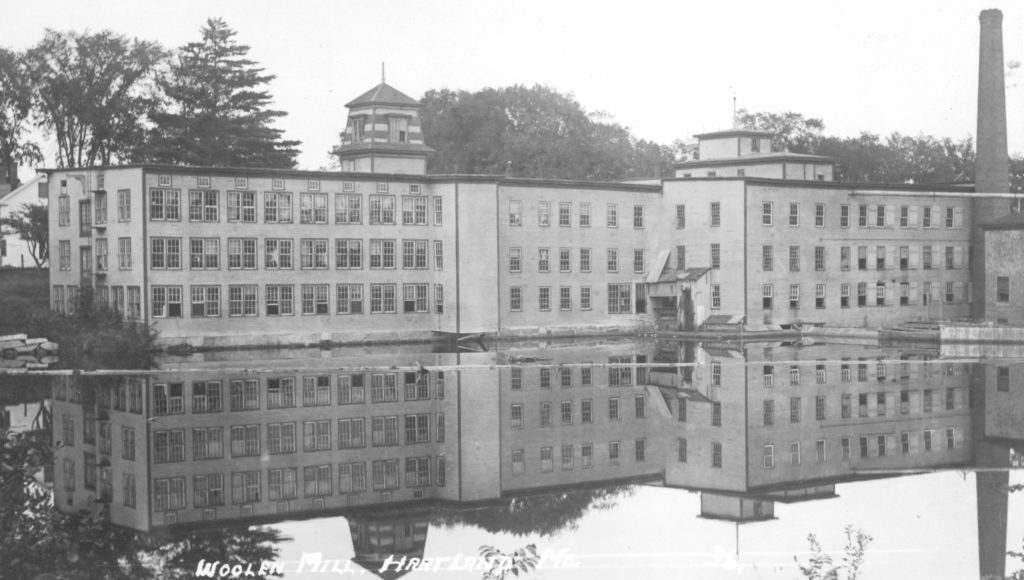
Former Upper Linn Woolen Mill
*
“The American Woolen Company was originally established in 1899 through the consolidation of eight financially troubled New England woolen mills. Overproduction, competition and poor management had brought the New England textile industry to its knees by the 1890s. In particular, family trusts, the main shareholders of many of the mills, insisted on receiving high dividends instead of making necessary capital improvements. At the company’s height in the 1920s, it controlled 20% of the country’s woolen production. It owned and operated 58 woolen mills across New England including Dover-Foxcroft, Fairfield, Madison, Newport, Oakland, Old Town, Pittsfield, Skowhegan and Hartland.”
*
Update in Progress!
Following the closure of the Linn Woolen Mills in August of 1914, the Trustees of the Linn Woolen Company Mortgage Bond foreclosed on the original 1908 mortgage on January 29, 1915 citing in part, “default in payment of the principal and interest of said bonds to which default has continued for 3 months”.
*
Details of the vast real estate holdings which had originally been mortgaged by the Linn Woolen Company on April 15, 1908 were included in the Trustees’ Notice of Foreclosure published by the Pittsfield Advertiser on February 11, 1915.
Linn Woolen Mill – Notice of Foreclosure Details – Pittsfield Advertiser – 11 Feb 1915
*
By November of 1915, the Trustees leased the idle woolen mills to the American Woolen Company for an initial 6 month period.
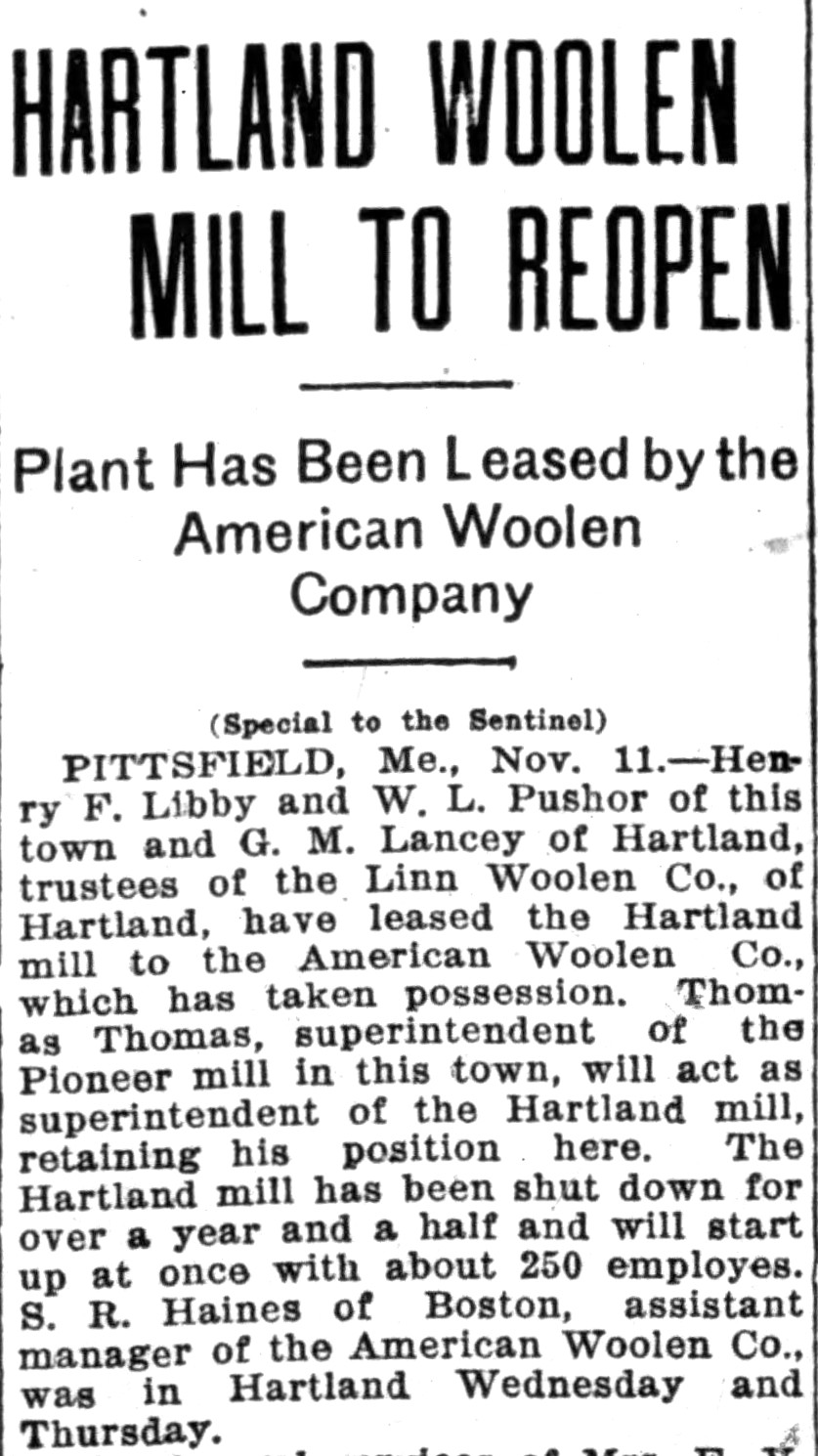
Published November 12, 1915 – Morning Sentinel
*

Published December 4, 1915 – Bangor Daily News
*
Near the end of the 6 month lease with the American Woolen Company in 1916, the Trustees of the Linn Woolen Company Mortgage Bond began making arrangements to auction off the mills. According to future reports, the Trustees felt on account of the European war, the woolen business was good and it was the best time to sell. The American Woolen Company fulfilled its existing orders then closed until a final resolution on the disposal of the properties was reached.
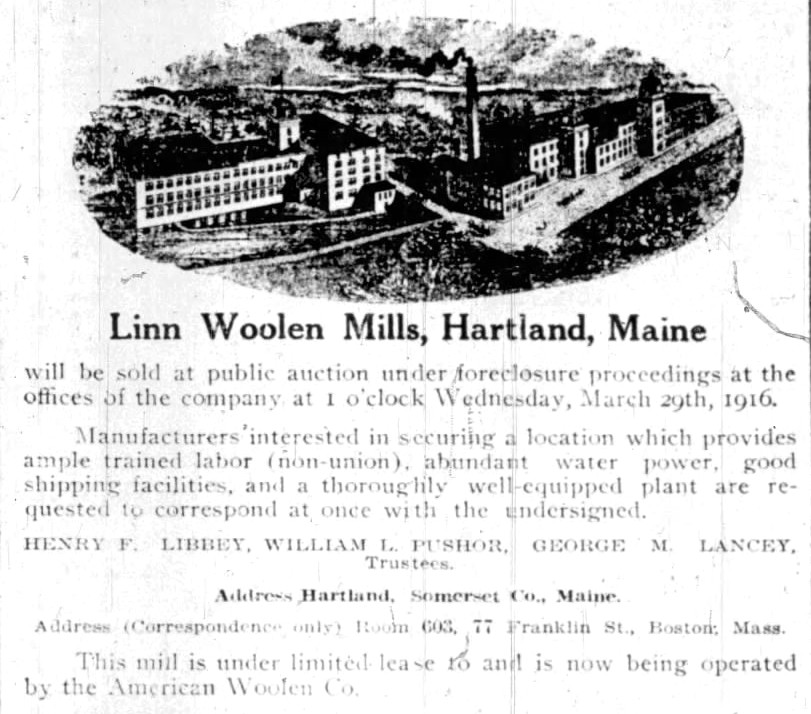
Published March 3, 1916 – The Commercial
*
The March 29th auction was initially postponed until April 18th when objections from other bond holders arose against the proposed sale claiming the property would bring more money if it was sold later. The April 18th auction was cancelled when those parties opposing the sale brought legal suit against the Trustees concerning the sale at a hearing which began on April 24, 1916.
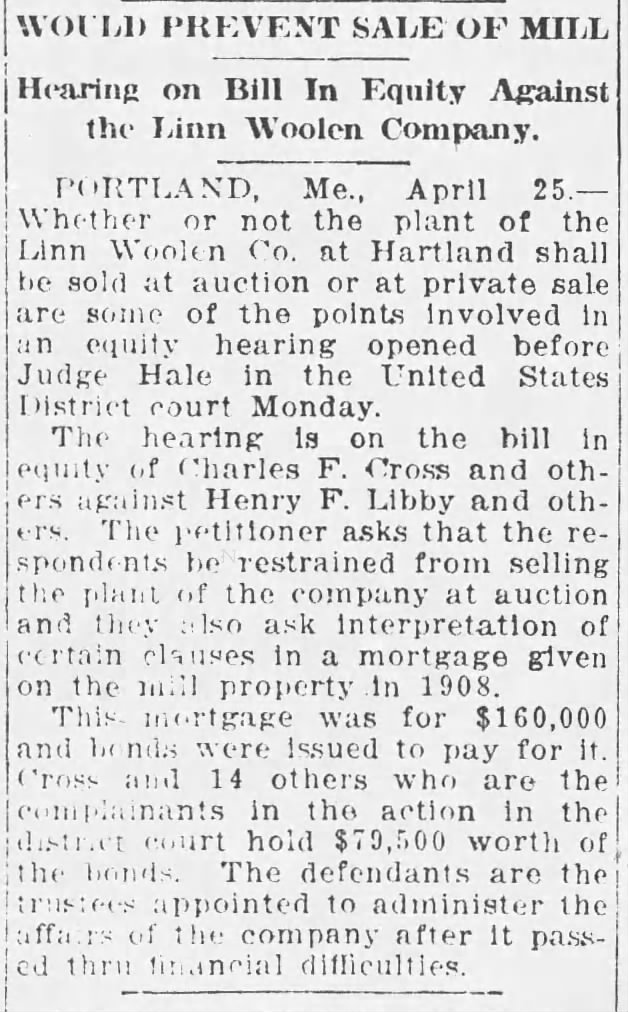
Published April 25, 1916 – Sun Journal
*
On April 25, 1916 the United States District Court in Portland ruled against an injunction preventing the sale of the Linn Woolen Mill clearing the way for a public auction to be held on May 2, 1916.
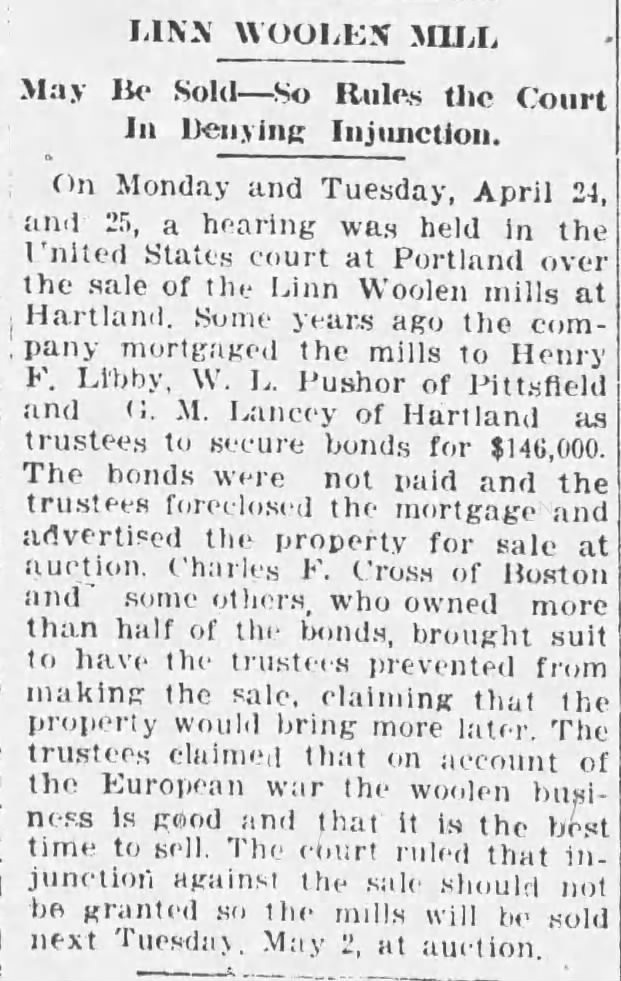
Published April 29, 1916 – Sun Journal
*
On May 2, 1916 the Linn Woolen Mills were sold by the Trustees of the Linn Woolen Company Mortgage Bond at public auction in Hartland to Henry P. Binney of Boston on behalf of the American Woolen Company.
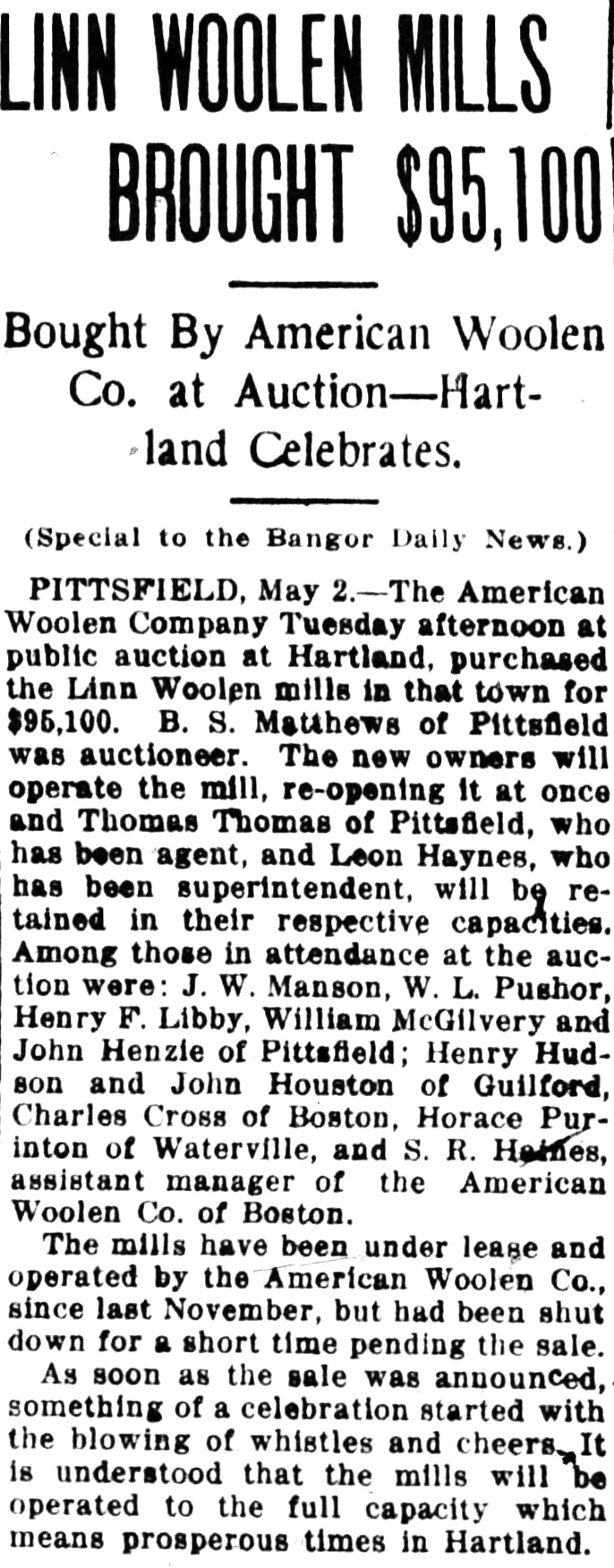
Published May 3, 1916 – Bangor Daily News
*
Another article provided further details of the auction and the properties included in the sale.
As noted, the American Woolen Company purchase included the 2 main woolen mills, several smaller mill related buildings and some of the vast real estate holdings of the Linn Manufacturing Company they had acquired or built. Many of these holdings were real estate, houses and buildings which Archibald Linn had purchased or built over the years before his death in 1889.

Published May 4, 1916 – Independent Reporter
*
After the May 2nd auction, the American Woolen Company made a few other separate noteworthy property purchases in Hartland over the next couple of years which would all later be part of their real estate holdings sold at auction in 1932.
On July 16, 1916, Mrs. Clara Belle (Osborne) Linn sold her Blake Street house to the American Woolen Company to be used as the residence of the new Hartland Resident Agent for the company, Thomas Thomas and his family. Mrs. Linn was the widow of Thomas A. Linn, former Treasurer of the Linn Woolen Company.
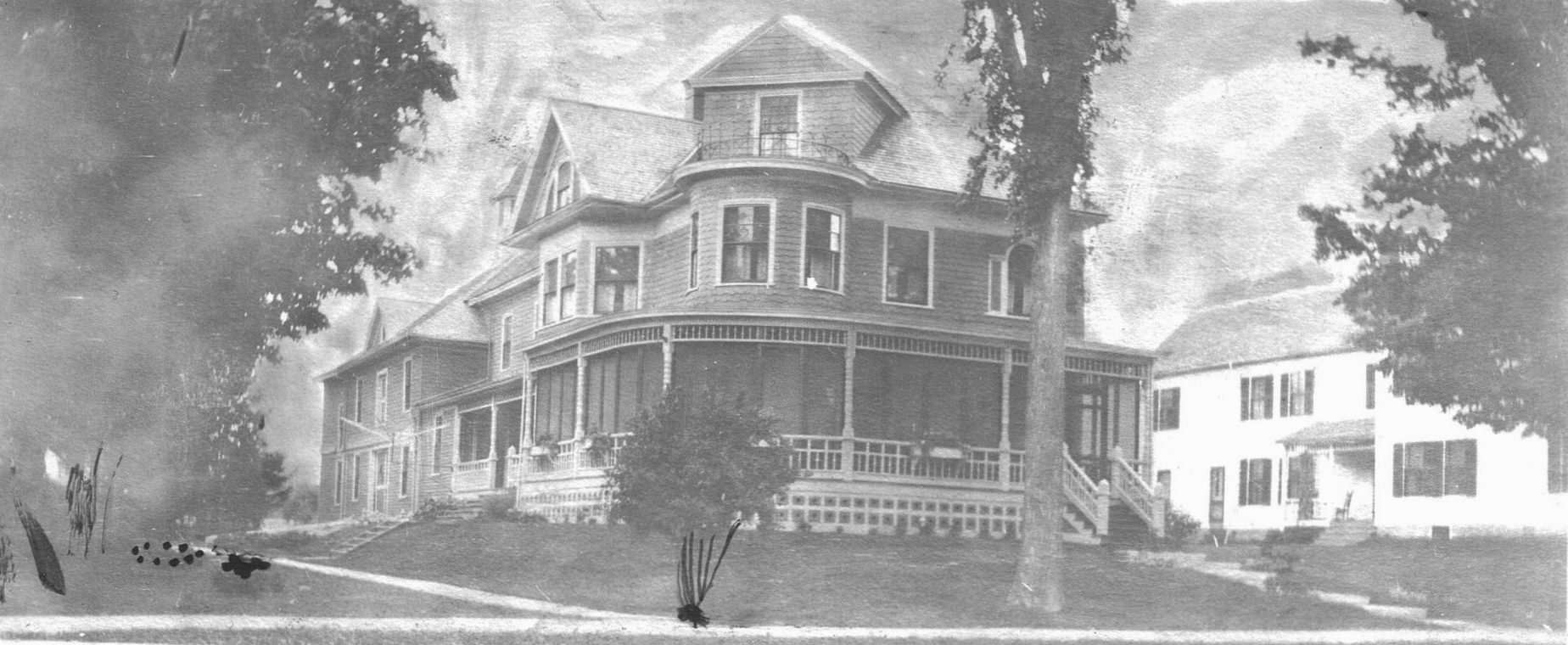
Former Thomas A. Linn Residence at corner of Academy & Blake Street
*
In 1919, Mrs. Mary (Linn) Fuller sold the house and part of the lot next to her Fuller Mansion residence on Elm Street to the American Woolen Company for additional accommodations of their management personal. Mrs. Fuller was the widow of Henry C. Fuller, former President of the Linn Woolen Company.
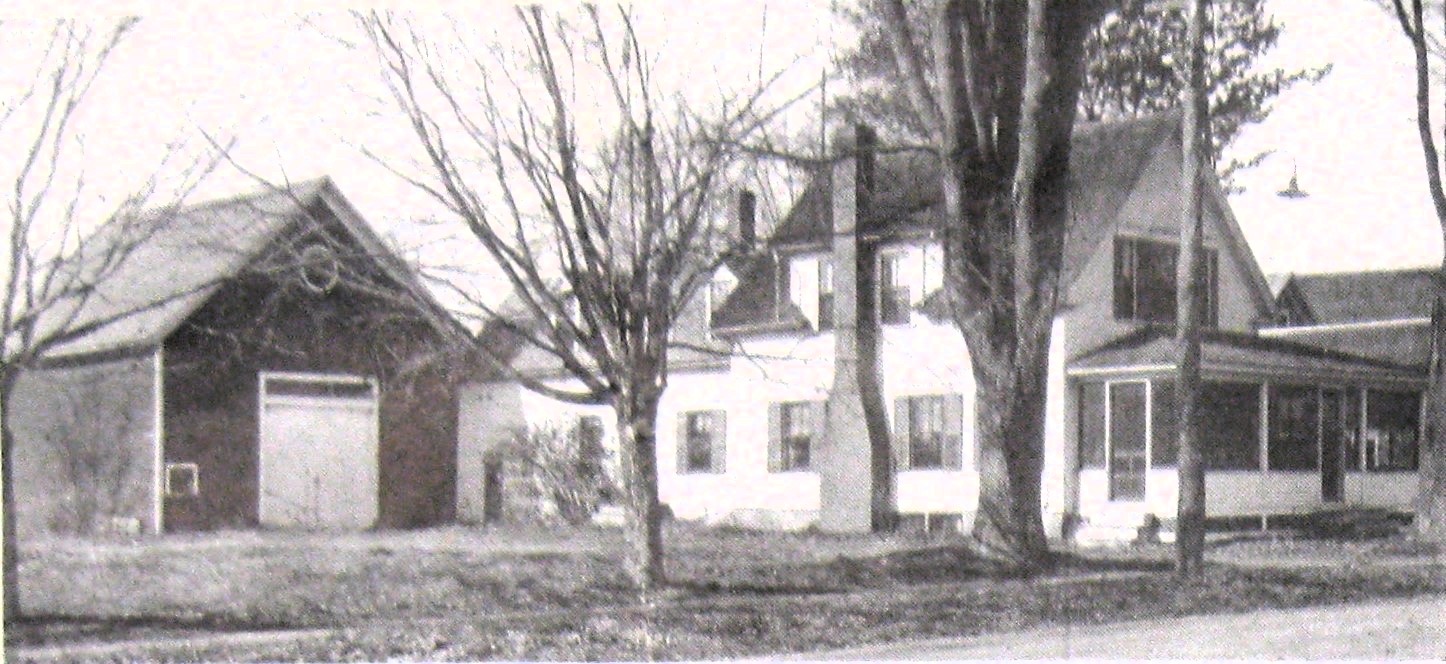
Elm Street House purchased by American Woolen Company in 1919
*
One of the first major upgrades made by the American Woolen Company in 1917 was to build a dedicated coal powered Boiler Room next to the lower mill replacing the former George W. Furber Jewelry Store (white building below). The Linn Woolen Mills had previously utilized the natural resources of the Sebasticook River as their primary power source for their operations first by water driven means and later by steam.
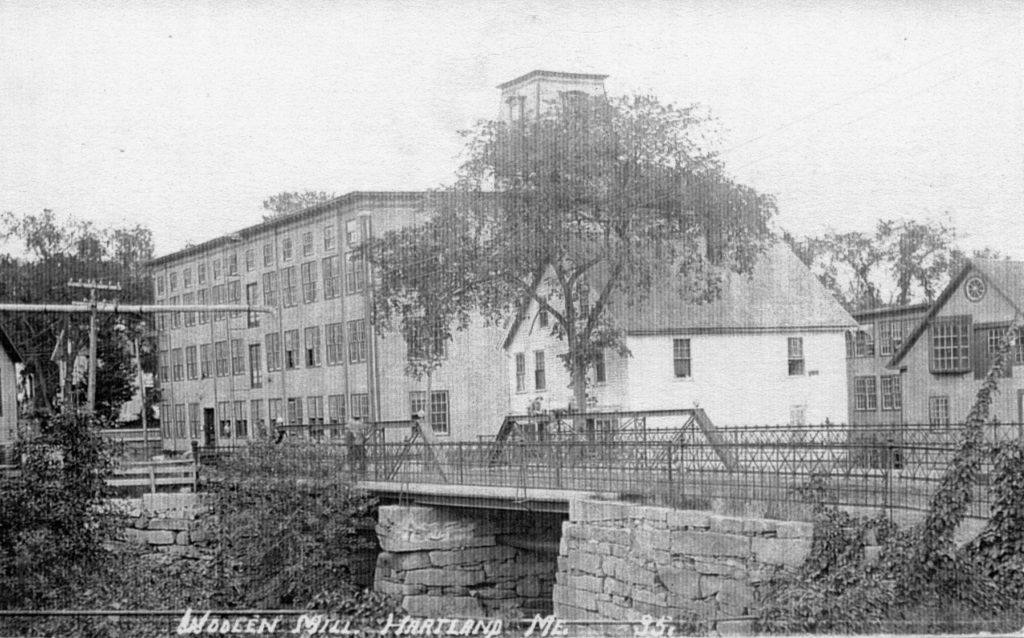
American Woolen Company Lower Hartland Mill before the Boiler Room was built
*
As noted on the crop of the Sanborn Fire Insurance Map in December of 1917, the new Boiler Room was “being built” at the time.

American Woolen Company – 1917
*
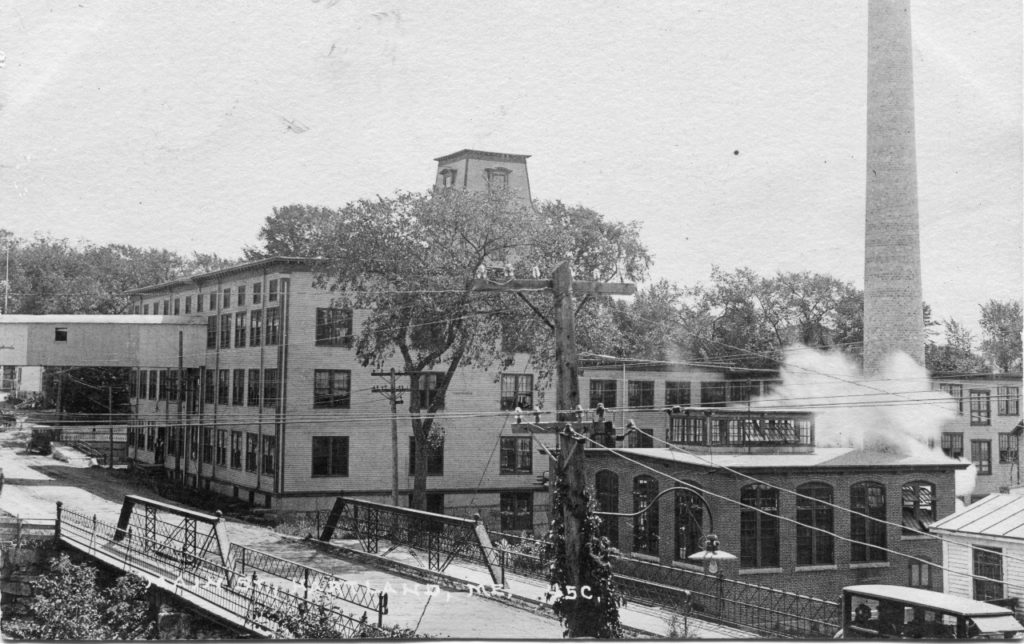
The new Boiler Room seen many years after it was built
*
The white building replaced by the new Boiler Room was moved further up Main Street to a lot owned by the American Woolen Company. The building had been home to several business going back before 1860 including George W. Furbush’s jewelry store in the late 1890s. The house and new property would be sold at the Great Auction of 1932 to Alton Leadbetter. It was purchased by Albert Deering, Jr by 1943 and later became the home of his son, Maynard Deering, Sr.
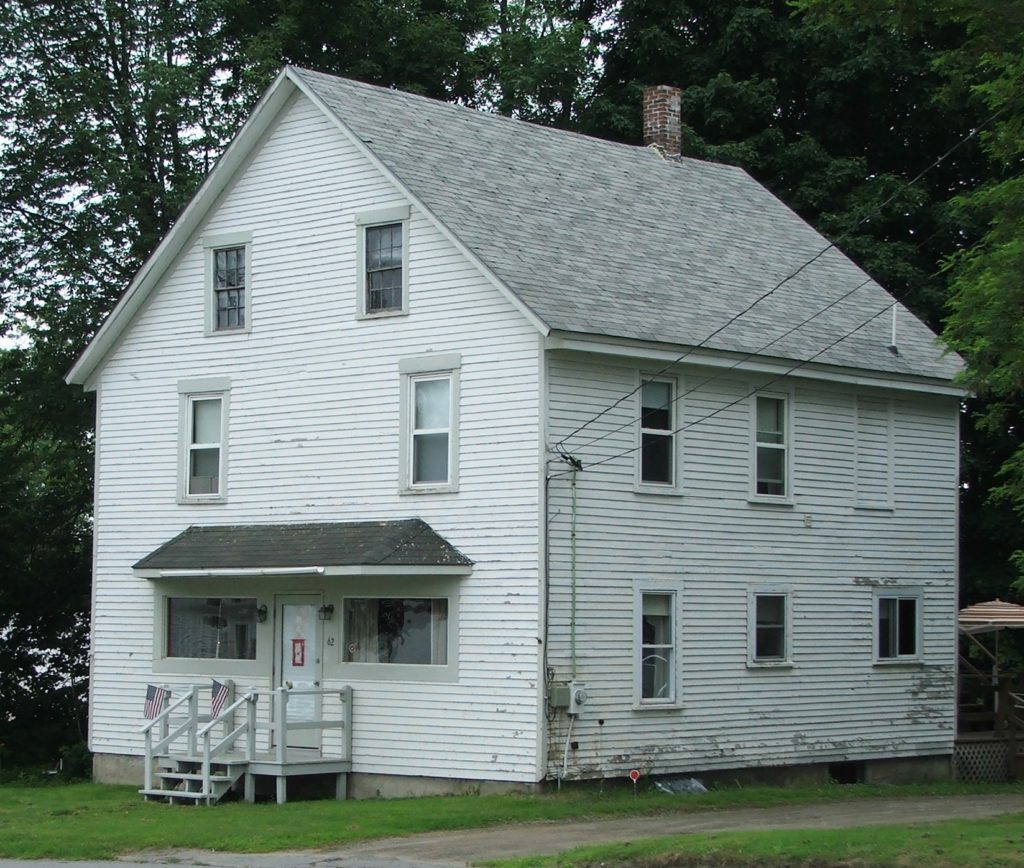
Former G. W. Furbush Jewelry Store moved further up Main Street – 2009
*
Although coal was readily available when the new Boiler Room was being built, an unusually bitter cold in December of 1917 throughout the Northeast caused severe coal shortages which continued into January and early February. By January 12, 1918, the country was concerned the shortage might affect war plants fueling America’s recent and escalating role on the Western Front of World War I.
Five days later, Harry Garfield, Supervisor of the Federal Fuel Administration, ordered all industrial plants east of the Mississippi close for five days and that “Fireless Mondays” were to be encouraged for weeks afterward. Despite several new lucrative U. S. Government contracts to supply troops with woolen blankets, the Hartland mill shut down numerous times during this coal shortage; often for several days in a row.

American Woolen Company Upper & Lower Woolen Mills in Hartland – Panoramic View – c1920
*
We cannot confirm these donated photos below were taken at the Hartland woolen mill, but they do represent a similar and unique glimpse into how many of the woolen mills looked like inside at the time.
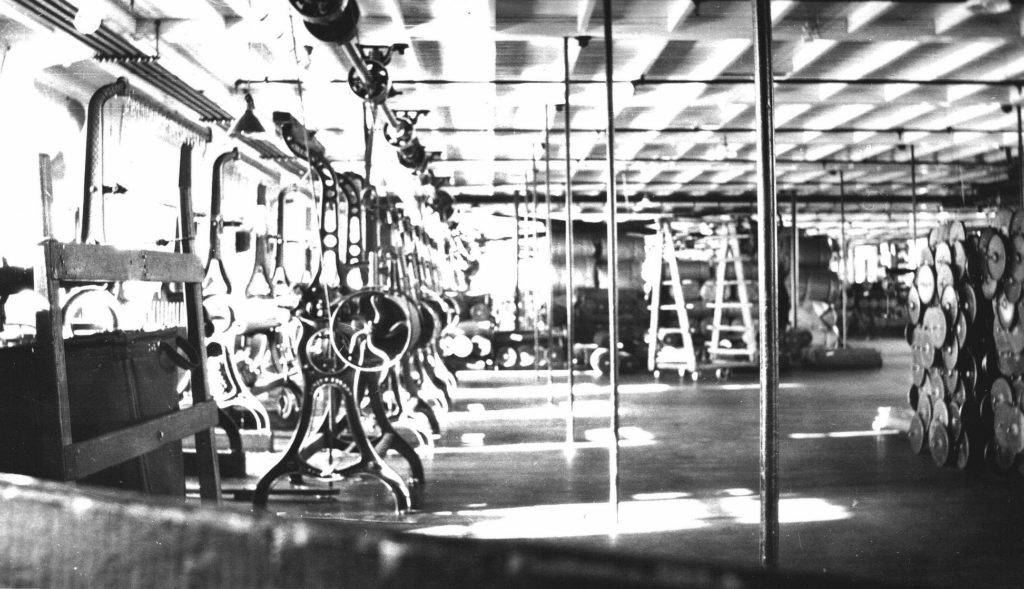
Unknown Woolen Mill Interior #1
*
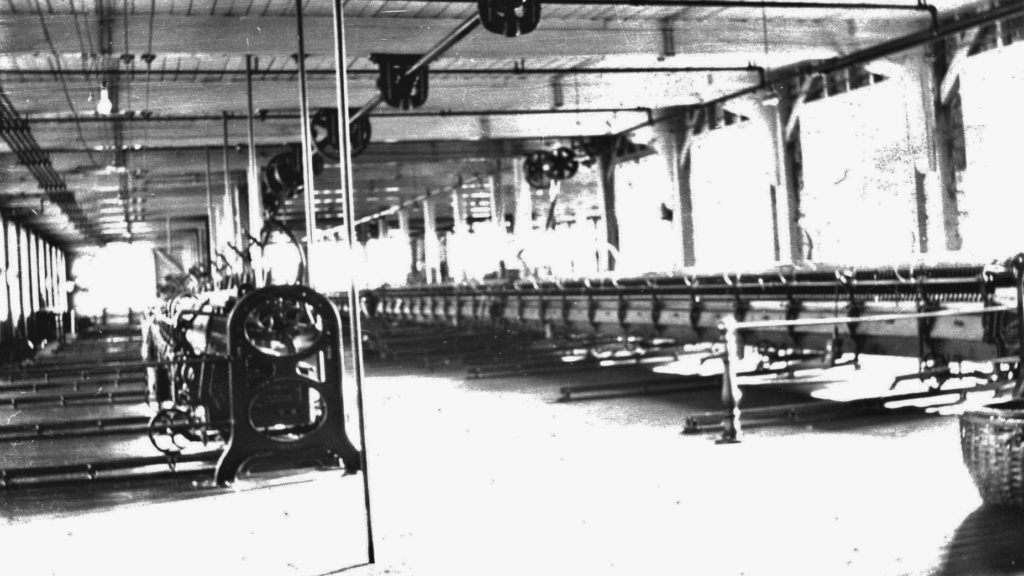
Unknown Woolen Mill Interior #2
*
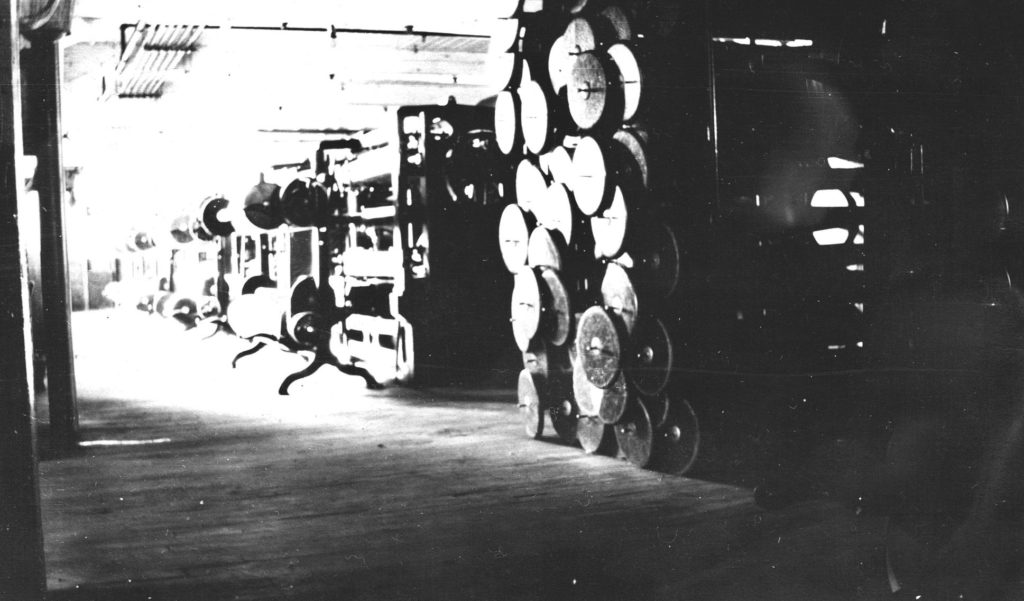
Unknown Woolen Mill Interior #3
*
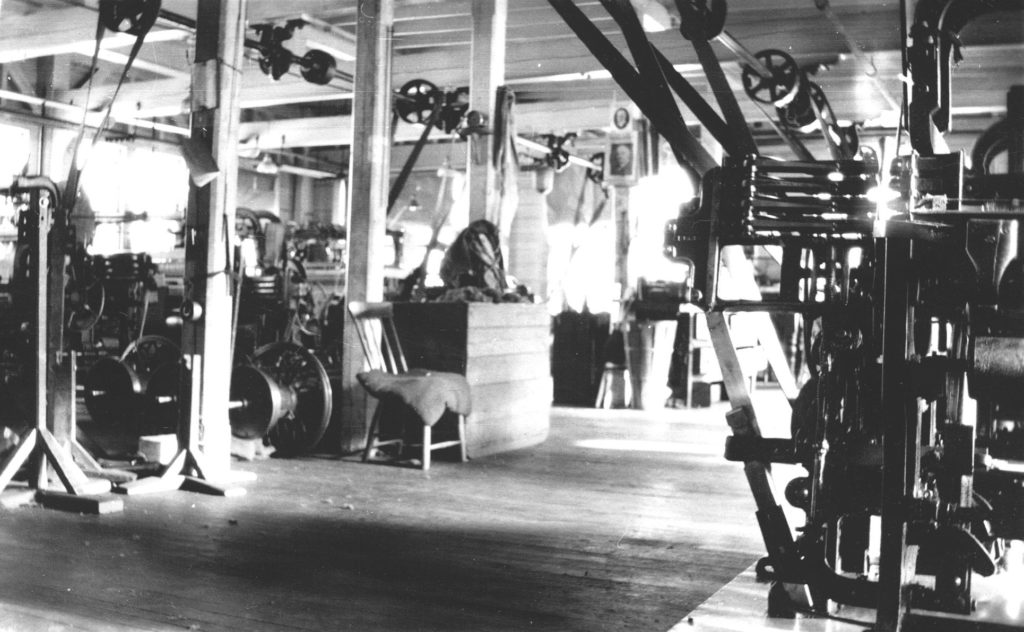
Unknown Woolen Mill Interior #4
*
The Great Flood of 1923 caused extensive damage once again to the woolen mills and surrounding area.
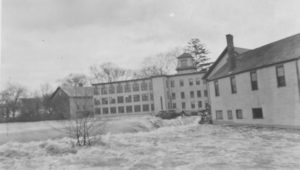
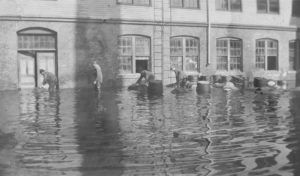
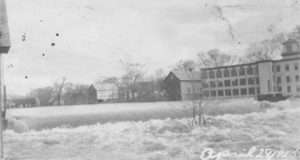
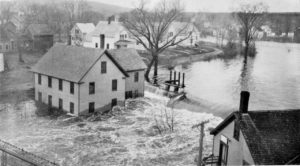
The Great Flood of 1923
*
For the next few years, the American Woolen Company operated successfully employing a couple hundred people from Hartland and surrounding towns. The woolen goods market remained strong following World War I and further local investments were made by the company including upkeep of 4 existing employee houses on Hubbard Avenue built by the Linn Manufacturing Company. Census Reports for Hartland from 1920 and 1930 indicate numerous people worked at the American Woolen Company mill, often times with several family members employed there, too.
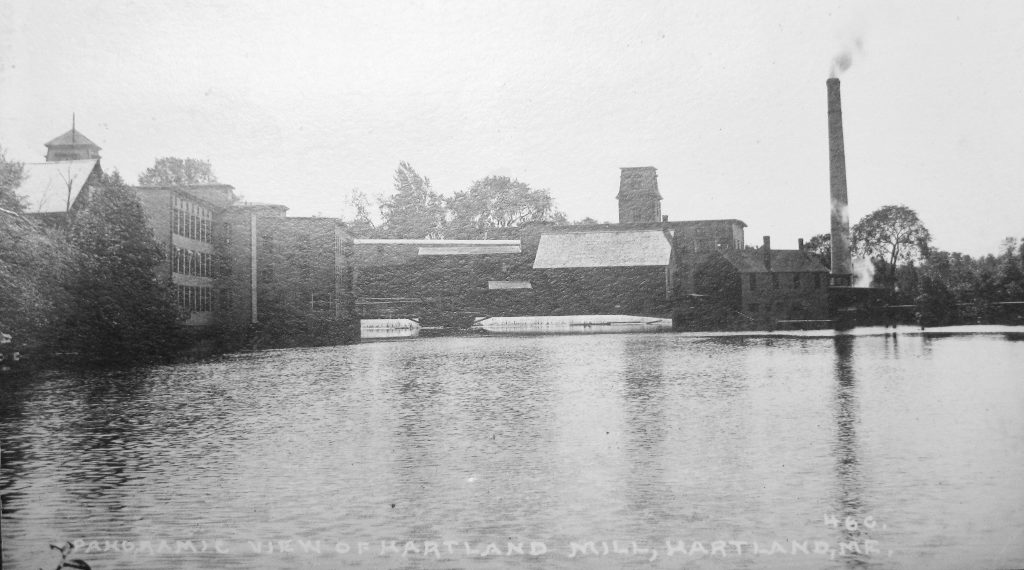
View from Sebasticook River
*
Overall, the American Woolen Company venture in Hartland was going well until October 29, 1929; now infamously known as “Black Tuesday”. While the 1929 Stock Market crash didn’t adversely affect the company or Hartland immediately, one of the first concerning events of the resulting national “Great Depression” came at the February 21, 1931 Town Meeting when the American Woolen Company requested a large tax break on all their Hartland properties because of their own overall economic woes throughout all their operations.
It was an early sign of trouble for the company which owned and operated some 60 woolen mills in New England including several in Maine. While the company made some efforts keep the Hartland mill open, in late 1932 they transferred all their non-manufacturing real estate holdings to the Textile Reality Company for disposal.
*
Shortly after the American Woolen Company transfer, most of the non-manufacturing real estate holdings it had owned in Hartland were sold at public auction on December 2, 1932. The auction did not include the 2 main mills or several of the smaller buildings on the mill property which were eventually abandoned and surrendered to the town after the mills closed. Full details may be found on our dedicated page of the Great Auction of 1932.
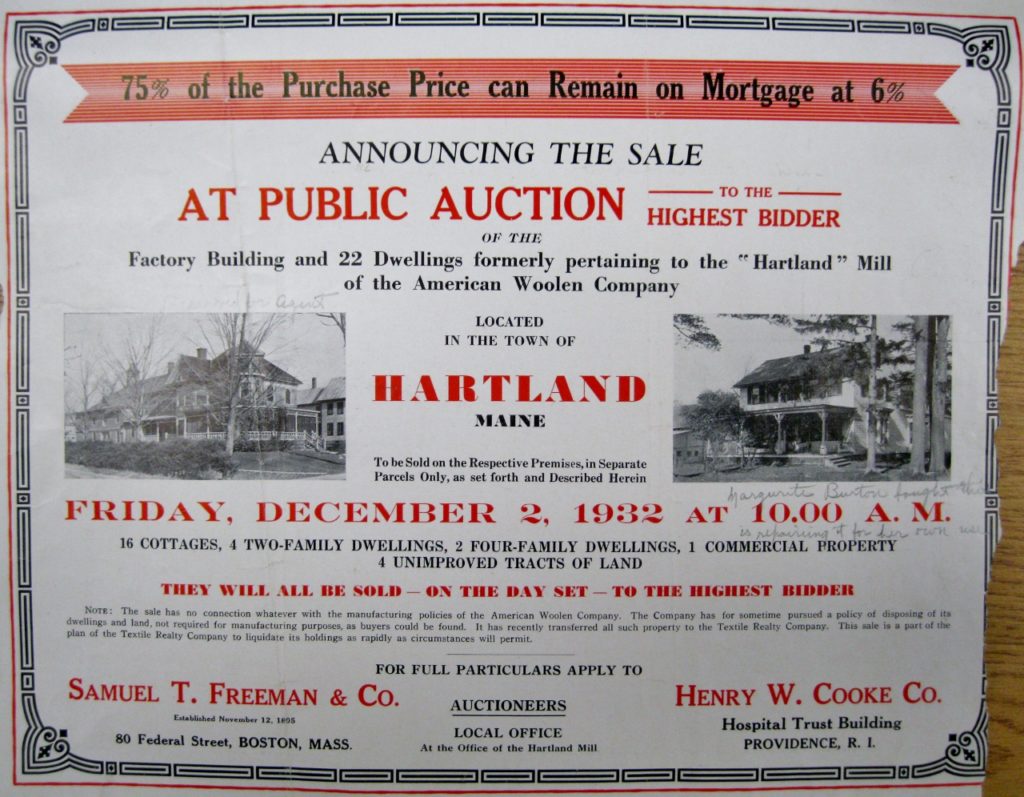
Cover of the Great Auction of 1932 Flyer
*
“Note: This sale has no connection whatever with the manufacturing policies of the American Woolen Company. The company has for some time pursued a policy of disposing of its dwellings and land, not required for manufacturing purposes, as buyers could be found. It has recently transferred all such property to the Textile Realty Company. This sale is part of the plan of the Textile Reality Company to liquidate its holdings as rapidly as circumstances will permit.” ~ Auction Flyer Cover Notation
*
The eventual closing of the American Woolen Company in Hartland meant a substantial loss of employment, tax income and a considerable strain on the local economy, all of which depended heavily on the woolen mill. Citizens knew the future of Hartland rested upon finding a suitable and long term replacement at the abandoned facility. Many of these citizens would quickly band together in one of the town’s greatest moments of cooperation in an unprecedented effort to bring a new industry to town with the formation of Hartland Mills, Incorporated.